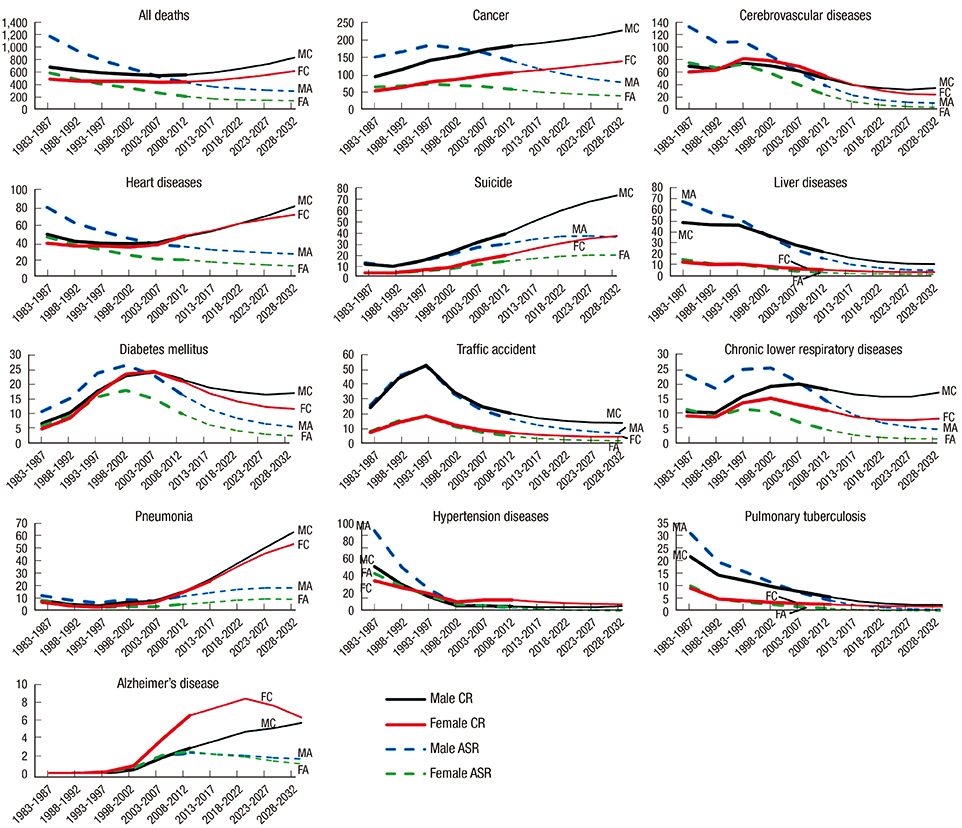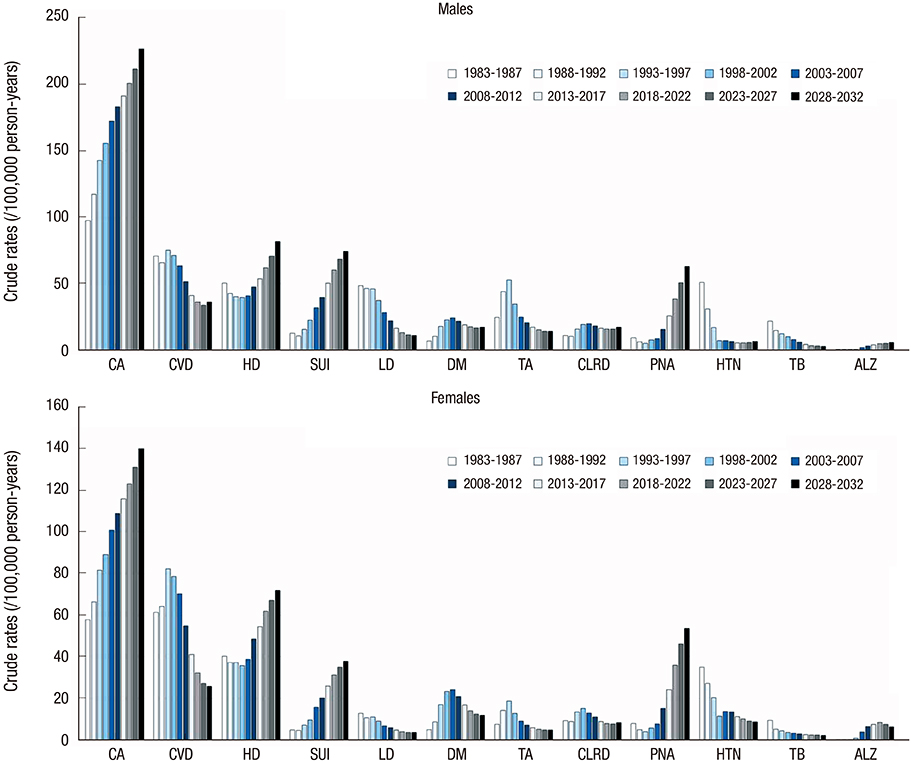J Korean Med Sci.
2016 Aug;31(8):1181-1189. 10.3346/jkms.2016.31.8.1181.
Forecasting Cause-Specific Mortality in Korea up to Year 2032
- Affiliations
-
- 1Department of Preventive Medicine, School of Medicine, Kangwon National University, Chuncheon, Korea. sonmia@kangwon.ac.kr
- KMID: 2373743
- DOI: http://doi.org/10.3346/jkms.2016.31.8.1181
Abstract
- Forecasting cause-specific mortality can help estimate the future burden of diseases and provide a clue for preventing diseases. Our objective was to forecast the mortality for causes of death in the future (2013-2032) based on the past trends (1983-2012) in Korea. The death data consisted of 12 major causes of death from 1983 to 2012 and the population data consisted of the observed and estimated populations (1983-2032) in Korea. The modified age-period-cohort model with an R-based program, nordpred software, was used to forecast future mortality. Although the age-standardized rates for the world standard population for both sexes are expected to decrease from 2008-2012 to 2028-2032 (males: -31.4%, females: -32.3%), the crude rates are expected to increase (males: 46.3%, females: 33.4%). The total number of deaths is also estimated to increase (males: 52.7%, females: 41.9%). Additionally, the largest contribution to the overall change in deaths was the change in the age structures. Several causes of death are projected to increase in both sexes (cancer, suicide, heart diseases, pneumonia and Alzheimer's disease), while others are projected to decrease (cerebrovascular diseases, liver diseases, diabetes mellitus, traffic accidents, chronic lower respiratory diseases, and pulmonary tuberculosis). Cancer is expected to be the highest cause of death for both the 2008-2012 and 2028-2032 time periods in Korea. To reduce the disease burden, projections of the future cause-specific mortality should be used as fundamental data for developing public health policies.
Keyword
MeSH Terms
Figure
Cited by 1 articles
-
Trends of Cause of Death among Human Immunodeficiency Virus Patients and the Impact of Low CD4 Counts on Diagnosis to Death: a Retrospective Cohort Study
Yoonjung Kim, Shin-Woo Kim, Hyun-Ha Chang, Ki Tae Kwon, Sohyun Bae, Soyoon Hwang
J Korean Med Sci. 2020;35(41):e355. doi: 10.3346/jkms.2020.35.e355.
Reference
-
1. Lozano R, Naghavi M, Foreman K, Lim S, Shibuya K, Aboyans V, Abraham J, Adair T, Aggarwal R, Ahn SY, et al. Global and regional mortality from 235 causes of death for 20 age groups in 1990 and 2010: a systematic analysis for the global burden of disease study 2010. Lancet. 2012; 380:2095–2128.2. Lim D, Ha M, Song I. Trends in the leading causes of death in Korea, 1983-2012. J Korean Med Sci. 2014; 29:1597–1603.3. Møller B, Fekjaer H, Hakulinen T, Tryggvadóttir L, Storm HH, Talbäck M, Haldorsen T. Prediction of cancer incidence in the Nordic countries up to the year 2020. Eur J Cancer Prev. 2002; 11:Suppl 1. S1–96.4. Møller B, Fekjaer H, Hakulinen T, Sigvaldason H, Storm HH, Talbäck M, Haldorsen T. Prediction of cancer incidence in the Nordic countries: empirical comparison of different approaches. Stat Med. 2003; 22:2751–2766.5. Møller H, Fairley L, Coupland V, Okello C, Green M, Forman D, Møller B, Bray F. The future burden of cancer in England: incidence and numbers of new patients in 2020. Br J Cancer. 2007; 96:1484–1488.6. Mistry M, Parkin DM, Ahmad AS, Sasieni P. Cancer incidence in the United Kingdom: projections to the year 2030. Br J Cancer. 2011; 105:1795–1803.7. Nowatzki J, Moller B, Demers A. Projection of future cancer incidence and new cancer cases in Manitoba, 2006-2025. Chronic Dis Can. 2011; 31:71–78.8. Rapiti E, Guarnori S, Pastoors B, Miralbell R, Usel M. Planning for the future: cancer incidence projections in Switzerland up to 2019. BMC Public Health. 2014; 14:102.9. Weir HK, Thompson TD, Soman A, Møller B, Leadbetter S. The past, present, and future of cancer incidence in the United States: 1975 through 2020. Cancer. 2015; 121:1827–1837.10. Olsen AH, Parkin DM, Sasieni P. Cancer mortality in the United Kingdom: projections to the year 2025. Br J Cancer. 2008; 99:1549–1554.11. Statistics Korea. Death cause statistics [Internet]. accessed on 1 February 2016. Available at http://kosis.kr/statHtml/statHtml.do?orgId=101&tblId=DT_1B80A13&conn_path=I2.12. Mathers CD, Fat DM, Inoue M, Rao C, Lopez AD. Counting the dead and what they died from: an assessment of the global status of cause of death data. Bull World Health Organ. 2005; 83:171–177.13. Statistics Korea. Future population projection [Internet]. accessed on 1 February 2016. Available at http://kosis.kr/statHtml/statHtml.do?orgId=101&tblId=DT_1B01003&conn_path=I2.14. Segi M, Kurihara M, Matsuyama T. Cancer Mortality for Selected Sites in 24 Countries: No. 5 (1964-1965). Tokyo: Japan Cancer Society;1969.15. Ahmad OB, Boschi-Pinto C, Lopez AD, Murray CJ, Lozano R, Inoue M. Age Standardization of Rates: a New WHO Standard (GPE Discussion Paper Series: No. 31). Geneva: World Health Organization;2001.16. Mathers CD, Loncar D. Projections of global mortality and burden of disease from 2002 to 2030. PLoS Med. 2006; 3:e442.17. Jung KW, Won YJ, Oh CM, Kong HJ, Cho H, Lee DH, Lee KH. Prediction of cancer incidence and mortality in Korea, 2015. Cancer Res Treat. 2015; 47:142–148.18. Secretan B, Straif K, Baan R, Grosse Y, El Ghissassi F, Bouvard V, Benbrahim-Tallaa L, Guha N, Freeman C, Galichet L, et al. A review of human carcinogens--part E: tobacco, areca nut, alcohol, coal smoke, and salted fish. Lancet Oncol. 2009; 10:1033–1034.19. Statistics Korea. Smoking prevalence [Internet]. accessed on 1 February 2016. Available at http://kosis.kr/statHtml/statHtml.do?orgId=101&tblId=DT_2KAAC04&conn_path=I2.20. Park S, Jee SH, Shin HR, Park EH, Shin A, Jung KW, Hwang SS, Cha ES, Yun YH, Park SK, et al. Attributable fraction of tobacco smoking on cancer using population-based nationwide cancer incidence and mortality data in Korea. BMC Cancer. 2014; 14:406.21. Shin A, Kim J, Park S. Gastric cancer epidemiology in Korea. J Gastric Cancer. 2011; 11:135–140.22. Koh SJ, Kim JS. The reasons for the increased incidence of colorectal cancer in Korea. Korean J Med. 2010; 79:97–103.23. Yusuf S, Reddy S, Ounpuu S, Anand S. Global burden of cardiovascular diseases: part I: general considerations, the epidemiologic transition, risk factors, and impact of urbanization. Circulation. 2001; 104:2746–2753.24. Yusuf S, Reddy S, Ounpuu S, Anand S. Global burden of cardiovascular diseases: part II: variations in cardiovascular disease by specific ethnic groups and geographic regions and prevention strategies. Circulation. 2001; 104:2855–2864.25. Khang YH, Yun SC. Trends in general and abdominal obesity among Korean adults: findings from 1998, 2001, 2005, and 2007 Korea National Health and Nutrition Examination Surveys. J Korean Med Sci. 2010; 25:1582–1588.26. Kwon JW, Chun H, Cho SI. A closer look at the increase in suicide rates in South Korea from 1986-2005. BMC Public Health. 2009; 9:72.27. Yoon HK. Changes in the epidemiology and burden of community-acquired pneumonia in Korea. Korean J Intern Med. 2014; 29:735–737.28. Janssens JP, Krause KH. Pneumonia in the very old. Lancet Infect Dis. 2004; 4:112–124.29. Maddrey WC. Hepatitis B: an important public health issue. J Med Virol. 2000; 61:362–366.30. Kim H, Shin AR, Chung HH, Kim MK, Lee JS, Shim JJ, Kim BH. Recent trends in hepatitis B virus infection in the general Korean population. Korean J Intern Med. 2013; 28:413–419.31. Park JH, Eum JH, Bold B, Cheong HK. Burden of disease due to dementia in the elderly population of Korea: present and future. BMC Public Health. 2013; 13:293.32. Reitz C, Brayne C, Mayeux R. Epidemiology of Alzheimer disease. Nat Rev Neurol. 2011; 7:137–152.33. Jürgens V, Ess S, Cerny T, Vounatsou P. A Bayesian generalized age-period-cohort power model for cancer projections. Stat Med. 2014; 33:4627–4636.34. Qiu Z, Jiang Z, Wang M, Hatcher J. Alberta Health Services for the Canadian Partnership Against Cancer. Long-Term Projection Methods: Comparison of Age-Period-Cohort Model-Based Approaches: Technical Report for Cancer Projections Network (C-Proj). Edmonton: Alberta Health Services;2010.
- Full Text Links
- Actions
-
Cited
- CITED
-
- Close
- Share
- Similar articles
-
- Cancer Mortality Projections in Korea up to 2032
- Prediction of Cancer Incidence and Mortality in Korea, 2013
- A Critical Review of Nurse Demand Forecasting Methods in Empirical Studies 1991~2014
- Prediction of Cancer Incidence and Mortality in Korea, 2014
- Prediction of Cancer Incidence and Mortality in Korea, 2017




